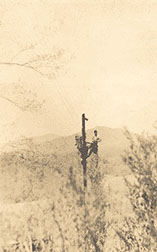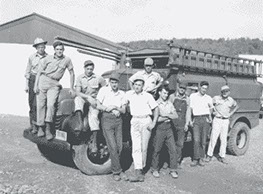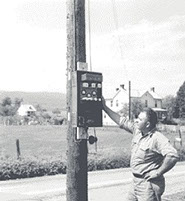


SEARCH MyCVEC
History
Principles
Facts
Power Supply
Board of Directors
Organization
Communities
Careers
In the Schools
 In 1937 only about 10% of Central Virginia's citizens in rural areas had electric service. In order to meet the need for rural access to electricity, a group of citizens in the Rockfish Valley area of Nelson County decided to explore the possibilities of forming an electric cooperative. They borrowed funds from the newly established Rural Electrification Administration (REA) to construct their own electric service system. Strong interest and rapid growth resulted in the formation of a county-wide organization. The application for a cooperative charter was executed at a well-attended meeting on September 20, 1937, at Lovingston High School. L.C. Dawson, S.T. Rodes, G.H. Whitehead, James Sites, F.R. Moon, and Fred Schilling were early proponents of the effort, and their leadership was rewarded when the State Corporation Commission granted the charter on September 22, 1937. Central Virginia Electric Cooperative was formed.
In 1937 only about 10% of Central Virginia's citizens in rural areas had electric service. In order to meet the need for rural access to electricity, a group of citizens in the Rockfish Valley area of Nelson County decided to explore the possibilities of forming an electric cooperative. They borrowed funds from the newly established Rural Electrification Administration (REA) to construct their own electric service system. Strong interest and rapid growth resulted in the formation of a county-wide organization. The application for a cooperative charter was executed at a well-attended meeting on September 20, 1937, at Lovingston High School. L.C. Dawson, S.T. Rodes, G.H. Whitehead, James Sites, F.R. Moon, and Fred Schilling were early proponents of the effort, and their leadership was rewarded when the State Corporation Commission granted the charter on September 22, 1937. Central Virginia Electric Cooperative was formed.
The directors of the new cooperative held their first board meeting an October 28, 1937, where they adopted the first Bylaws and authorized the signing of a contract to buy power from the Virginia Farm Power Board, Inc. Also at this meeting the board members signed applications for service and paid their $5 membership fees, thus becoming the first applicants for service from the Cooperative.
 The Cooperative was the only means these farm leaders could see for getting electric service, so they promptly began the task of signing up applicants in order to meet REA's feasibility requirements of two consumers per mile of line.
The Cooperative was the only means these farm leaders could see for getting electric service, so they promptly began the task of signing up applicants in order to meet REA's feasibility requirements of two consumers per mile of line.
Crew with Truck, 1940's
On December 29, 1937, the Board of Directors authorized the first loan from REA in the amount of $100,000, bearing interest at the rate of 2.88%. This loan funded the construction and operation of 129 miles of electric distribution lines in Albemarle, Amherst, Appomattox, and Nelson Counties to serve around 400 members. Perkins & Barnes Construction Company was awarded the contract for a 150 kVA substation at Afton with lines extending to the Forks of Buffalo, and for another 150 kVA substation at Appomattox with lines extending to Bent Creek and east along the James River to Howardsville. This first contract was for the amount of $98,509.18.
 Checking a Box
Checking a Box
Mr. Lewis A. Bress was appointed Project Superintendent in November 1937, and the Co-Op opened its first office in December. Two downstairs rooms in the residence of Frank Stevens, across from the Nelson County Court House, were rented for office facilities. The basement of the Stevens home was rented as a storeroom and stocked with a very small quantity of materials bought from Perkins & Barnes after the company completed its contract.
 The dream of these farmers who had worked so diligently in organizing the Co-Op began to be realized in September 1938 when the first line was energized. The contractor was asked to connect a light bulb at the transformer near Farrar's Store on Rt. 151 so people would know the line was hot. The Co-Op hired the superintendent of Perkins & Barnes' Afton job, J. H. Gardner, as its first maintenance man.
The dream of these farmers who had worked so diligently in organizing the Co-Op began to be realized in September 1938 when the first line was energized. The contractor was asked to connect a light bulb at the transformer near Farrar's Store on Rt. 151 so people would know the line was hot. The Co-Op hired the superintendent of Perkins & Barnes' Afton job, J. H. Gardner, as its first maintenance man.
CVEC Truck with REA logo, 1940's
In 1938, people in the rural areas of Fluvanna County area asked to join in the new cooperative. This action was authorized in July 1938, and three new directors were added from Fluvanna: H.G. Black, A.G. Wright, and John S. Farrar. The Co-Op began immediately to make plans to serve these new members. One substation provided circuits from Palmyra to Scottsville, another to the Cumberland County area, and the third to Zion Crossroads and west on Rt. 250 to Keswick.
These projects represented all major Co-Op construction completed prior to World War II. Due to shortages of materials and labor during the war, construction was limited to building short taps and maintaining the existing system.
During the post-World War II building boom, poles were not available. The Cooperative bought from local farmers pine poles meeting specifications and trucked them to a treating plant in order to continue much needed line expansion. Construction to serve the many Central Virginia families still waiting for service progressed rapidly until all members of the Cooperative were accommodated.
Central Virginia Electric Cooperative has been a pioneer in many areas of the utility business. The transformer maintenance shop constructed in Lovingston in the 1940's was used as a model for an REA design guide issued to Co-Ops nationwide. CVEC was the first cooperative nationally to receive REA approval for a peak shaving diesel generator plant (Ellis Generating Station) in 1994. The Cooperative continues to search for the best methods to serve it members today.
 CVEC Work Crew
CVEC Work Crew
CVEC has also been a leader in the application of new right-of-way control methods that are now universally accepted. A 1939 Board resolution stated that the policy of the Co-Op would be to decrease the span or distance between poles in wooded areas so that the wind would not sway the lines into trees. Line-sway was recognized as the cause of many outages, and the new practice reduced the number of outage hours. In 1953, the Co-Op instituted a right-of-way improvement program that required rights-of-way to be bulldozed to an adequate width and seeded. This initial effort was supported by regular maintenance to prevent the regrowth of trees under the power lines. The new procedure precluded the need to decrease the distance between poles in the forest.
From its modest beginning in 1937, Central Virginia Electric Cooperative has become one of the major businesses in rural Central Virginia, serving nearly 35,000 members on almost 4,600 miles of line. The Cooperative employs over 105 people to operate the business and to provide dependable low-cost electric service throughout its 14-county Central Virginia area.
The utility business has changed rapidly in the past 77 years, but your Cooperative is still working to provide the most reliable service at the most affordable price to our members. If you tend to take your Co-Op for granted, then that means that the company is fulfilling its mission:
"Working together
to improve the quality of life for our members
in a quietly impressive way."
HOME | REPORT AN OUTAGE | PAY MY BILL | CONTACT CVEC
Phone: 434.263.8336 | Toll free: 800.367.2832 | Fax: 434.263.8339
Corporate Headquarters:
800 Cooperative Way
Arrington, VA 22922
Payments:
Dept. 1340 | PO Box 2153
Birmingham, AL 35287-1340
Correspondence:
P. O. Box 247
Lovingston, VA 22949
